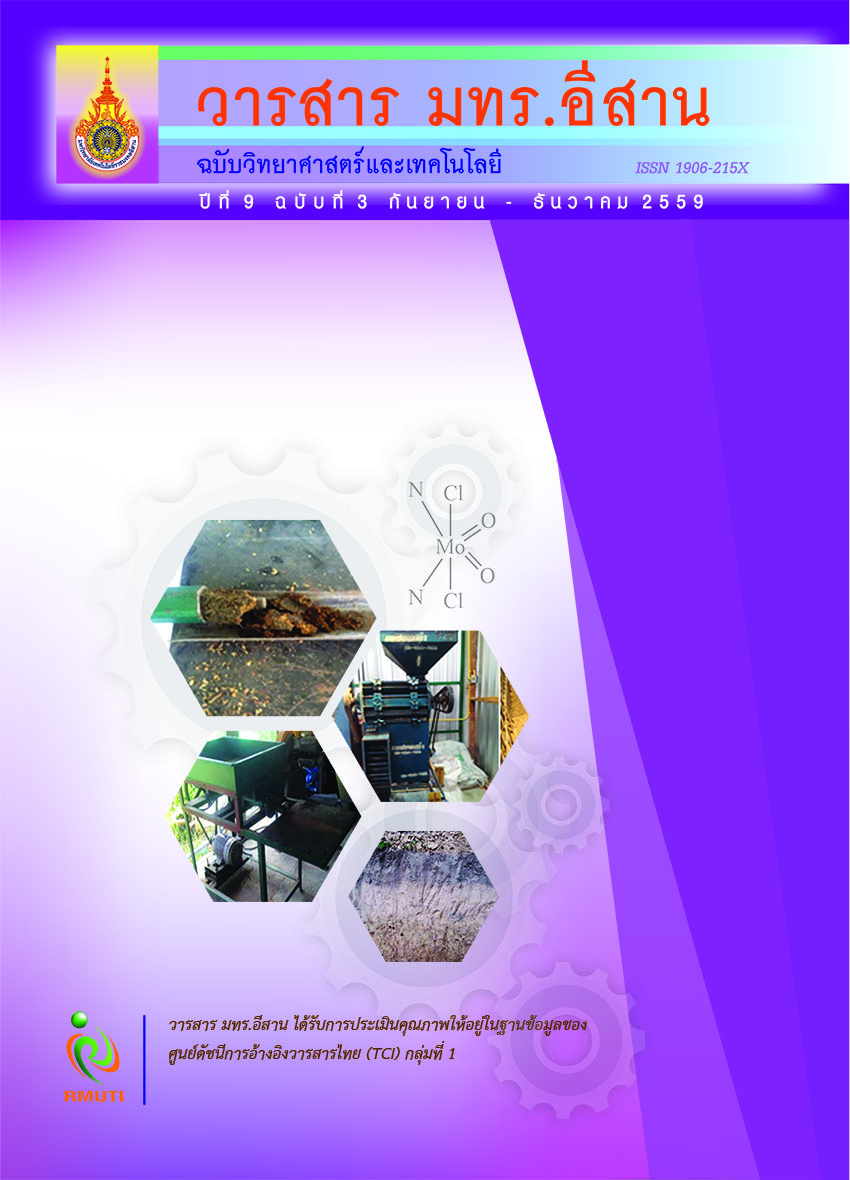การศึกษาจลนศาสตร์การอบแห้งเนื้อหมูด้วยเครื่องอบแห้งพลังงานแสงอาทิตย์ Drying Kinetics of Pork by Using Solar Dryer
Main Article Content
Abstract
บทคัดย่อ
การวิจัยครั้งนี้มีวัตถุประสงค์เพื่อศึกษาจลนศาสตร์การอบแห้งของเนื้อหมูที่อบด้วยเครื่องอบแห้ง
พลังงานแสงอาทิตยแ์ ละการตากแดด และศึกษาประสิทธิภาพเชิงความรอ้ นของระบบอบแหง้ ดว้ ยเครื่องอบแหง้
พลังงานแสงอาทิตย์ โดยใช้เนื้อหมู ขนาด 5 × 3 × 1 ซม. จำนวน 2 กิโลกรัม ความชื้นเริ่มต้น 254 %d.b.
อบในเครื่องอบแห้งพลังงานแสงอาทิตย์ และตาดแดด จนกระทั่งมีความชื้นสุดท้ายเท่ากับ 70 %d.b.
ทำการทดลองในช่วงเวลา 09.00 - 16.00 น. ผลการวิจัยพบว่า ความชื้นและอัตราความชื้นของเนื้อหมู
ที่อบด้วยเครื่องอบแห้งพลังงานแสงอาทิตย์จะลดลงเร็วกว่าการตากแดด โดยที่เครื่องอบแห้งพลังงาน
แสงอาทิตย์ใช้เวลาในการอบแห้ง 330 นาที ส่วนการตากแดดใช้เวลา 360 นาที เครื่องอบแห้งพลังงาน
แสงอาทิตย์มีประสิทธิภาพเชิงความร้อนของระบบในการอบแห้งเนื้อหมูสูงกว่าการตากแดด
Abstract
This research aimed to investigate the drying kinetics of pork using solar dryer and
open sun drying and the thermal efficiency of solar dryer. The solar dryer and open sun
drying were the experiment equipment. A 2 kg pork with a dimension of 5 × 3 × 1 cm.,
with the initial moisture content of 254 %d.b. were dried by using solar dryer and open
sun drying, to a final moisture content of 70 %d.b.. The results of this study showed
that the moisture content and moisture rate of pork drying using solar dryer was
faster than the open sun drying. The drying time for each drying method were 330 and
360 minutes, respectively. The thermal efficiency of the solar dryer for pork drying is
higher than open sun drying.
Article Details
References
[2] Perera, C.O. and Rahman, M. S. (1997). Heat Pump Dehumidifier Drying of Food. Trends in Food Science and Technology. Vol. 8. pp. 75-79
[3] Soponronnarit, S., Achariyaviriya, S. and Tasaso, P. (1992). Optimum Strategies for Drying Papaya Glace. ASEAN Food Journal. Vol. 7. No. 1. pp. 17-22
[4] Condori, M., Echazu, R. and Saravia, L. (2001). Solar Drying of Sweet Pepper and Garlic Using the Tunnel Greenhouse Dryer. Renewable Energy. Vol. 22. pp. 447-460
[5] Viriyaaompaivong, S. (2004). Solar Dryer by Forced Convection. Faculty of Engineering, Mahasarakham University. (In Thai)
[6] Usub, T., Poomsa-ad, N. and Lertsatitthanakorn, C. (2013). Solar Drying of Pork Using a Solar Tunnel Dryer with Thermal Storage. Journal of Science and Technology Mahasarakham University. Vol 32. No. 4. pp. 489-493 (In Thai)
[7] Mahmuto lu, T., Emir, F. and Sayg , Y.B. (1996). Sun/Solar Drying of Differently Treated Grapes and Storage Stability of Dried Grapes. Journal of Food Engineering. Vol. 29. pp. 289-300
[8] Doymaz, I., Tu rul, N. and Pala, M. (2006). Drying Characteristics of Dill and Parsley Leaves. Journal of Food Engineering. Vol. 77. pp. 559-565
[9] Celma, A.R., Rojas, S. and L pez, F., Montero, I. and Miranda, T. (2007). Thin Layer Drying Behaviour of Sludge of Olive Oil Extraction. Journal of Food Engineering. Vol. 80. pp. 1261-1271
[10] Crank, J. (2001). The Mathematics of Diffusion. second ed. Oxford, Oxford University Press
[11] Karathanos, V.T., Villalobos, G. and Saravacos, G.D. (1990). Comparison of Two Methods of Estimation of the Effective Moisture Diffusivity from Drying Data. Journal of Food Science. Vol. 55. No. 1. pp. 218-231
[12] Banout, J., Ehl, p., Havlik, j., Lojka, B., Polesny, Z. and Verner, V. (2011). Design and Performance Evaluation of a Double-Pass Solar Drier for Drying of Red chilli (Capsicum annum L.). Solar Energy. Vol. 85. pp. 506-515
[13] Sucreep, N. and Rattanawong, B. (2012). Pork Drying by Using Hang Solar Dryer. Faculty of Science, Udon Thani Rajabhat University. (In Thai)
[14] Devahastin, S. (2012). Drying of Food and Biomaterials. Bangkok: Top. pp. 23-26 (In Thai)
[15] Phongtarakulpanit, A., Prasit, B., Mansiri, K. and Srikeaw, S. (2005). A Design of Plant Paper Solar Dryer. School of Renewable Energy Technology, Naresuan University. pp. 22-25 (In Thai)


